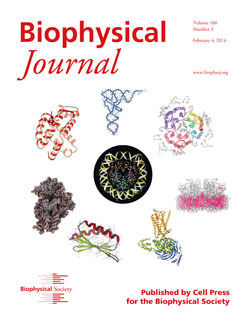
Rather than a specific area of our research, the review article in the February 4 Biophysical Journal, was motivated by the United Nations declaring 2014 as the “International Year of Crystallography,” and by the ways that event is being celebrated at the annual meeting in San Francisco: a main symposium ("X-rays are Photons Too"), the Biophysics 101 topic, and a session on instrumental resources at the national labs. We were not there for the first X-ray diffraction 100 years ago, but we were caught up as the first wave of macromolecular crystallography blossomed 54 years ago. We've always considered macromolecular structures both elegantly beautiful and best understood through graphic images, so each of the review's 54 chosen crystal structures is illustrated by a drawing, a computer image, or an animation. Having all those lovely, varied pictures made it irresistible to try for a cover, but choosing the right few was hard.
The upper four images represent historical moments: the very first protein structures (myoglobin & hemoglobin), the first large RNA (tRNA), the first membrane protein by electron crystallography (bacteriorhodopsin), and the centerpiece of last year's National Lecture (a nucleosome). The lower four represent the subjects of the symposium talks: two hot recent structures, a ribosome (E coli 70S) and a G-protein-coupled receptor (with its G protein), and two hot current methods developments, harnessing prediction software to help solve difficult crystal structures (symbolized by the landmark TOP7 design) and diffract-and-destroy nanocrystallography by free electron laser (photosystem II). The pleasing circular layout was contributed by Editor-in-Chief Les Loew.
We do feel that scientific art contributes in both directions -- good scientific illustrations are often worthy of walls and museums, and the most aesthetically satisfying of those images communicate a unifying principle within complexity. Our research website is at http://kinemage.biochem.duke.edu
including MolProbity validation; our drawings and computer graphics are described at "Ribbon diagram" and "Kinemage" on Wikipedia; and the largest collection of our images is at http://commons.wikimedia.org/wiki/User:Dcrjsr open license.
--Jane and Dave Richardson